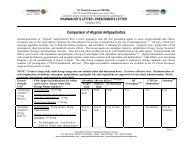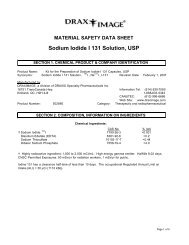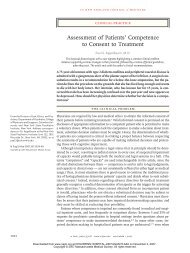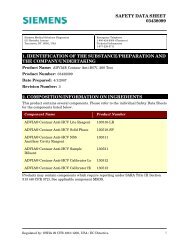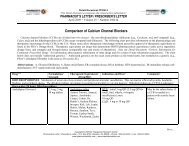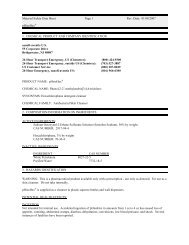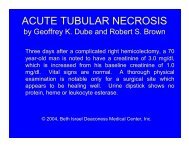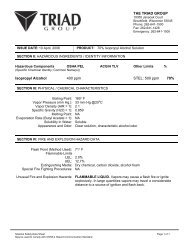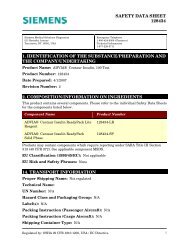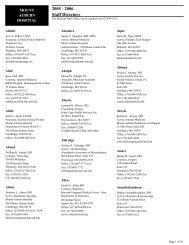Troponin - Non-MI Causes of Troponin Elevation
Troponin - Non-MI Causes of Troponin Elevation
Troponin - Non-MI Causes of Troponin Elevation
You also want an ePaper? Increase the reach of your titles
YUMPU automatically turns print PDFs into web optimized ePapers that Google loves.
published. 25–28 Ammann et al 25 evaluated patientswith sepsis, 40% <strong>of</strong> whom were in shock. Seventeen<strong>of</strong> their 20 patients (85%) had TnI elevation. TnIlevels ranged from 0.17 to 15.4 ng/mL, with amedian value <strong>of</strong> 0.57 ng/mL. ver Elst et al 26 foundTnI levels <strong>of</strong> at least 0.4 ng/mL in 50% <strong>of</strong> their 46patients with early septic shock. Similarly, a relativelylow median level (1.4 ng/mL) <strong>of</strong> the peak concentrations<strong>of</strong> TnI was observed in this study. In patientswith severe sepsis, septic shock, or hypovolemicshock, Arlati et al 27 found elevated TnI elevation in74% <strong>of</strong> the cases. All <strong>of</strong> their 12 patients withhypovolemic shock and 58% <strong>of</strong> those with severesepsis or septic shock had elevated TnI.<strong>Elevation</strong> <strong>of</strong> TnT in sepsis has also been reported.26,28 ver Elst et al 26 found cardiac TnT elevations( 0.1 ng/mL) in 36% <strong>of</strong> their cases. A muchhigher incidence <strong>of</strong> TnT elevation was reported bySpies et al 28 ; in their 26 patients with sepsis, 69% hadTnT levels 0.2 ng/mL.Furthermore, elevations <strong>of</strong> troponin in these patientsappear to correlate with severity <strong>of</strong> the diseaseprocess. TnI levels were found to correlate with thedegree <strong>of</strong> hypotension 27 and APACHE (acute physiologyand chronic health evaluation) II score. 26The causes <strong>of</strong> troponin elevations in these criticallyill patients are not well understood. Thesereports, in general, had a relatively small sample sizeand included a heterogeneous group <strong>of</strong> patients.Some <strong>of</strong> these patients had CAD, and stress-induced<strong>MI</strong> may have been responsible for troponin releasein this particular subgroup <strong>of</strong> patients. Acute coronaryevents have, however, been excluded in some <strong>of</strong>these patients. For example, Ammann et al 25 wereable to exclude CAD in 10 <strong>of</strong> 17 TnI-positivepatients. These findings indicated that other mechanismsare also involved.In one study, 26 patients with elevated troponinlevels are older and more likely to have hypertensionor previous history <strong>of</strong> <strong>MI</strong>, suggesting that theirunderlying cardiovascular disease may, to some degree,contribute to troponin elevation. However,these findings were not observed in another study. 28It also remains unclear whether infection with anyspecific pathogens is more likely to result in troponinelevations. Streptococcal pneumoniae infection wasthe cause <strong>of</strong> sepsis in 41% <strong>of</strong> TnI-positive patients inone study, 25 whereas Gram-negative bacteria werethe <strong>of</strong>fending pathogens in 63% <strong>of</strong> cases in anotherstudy. 26 Spies et al 28 found no difference in terms <strong>of</strong>the causes <strong>of</strong> sepsis between patients with or withouttroponin elevation.Nevertheless, there are several potential mechanisms,other than acute <strong>MI</strong>, for troponin release inseptic patients. First, it is well known that a number<strong>of</strong> local and circulating mediators (eg, cytokines orreactive oxygen species) possess direct cardiac myocytoxicproperties. 26 Secondly, myocardial injuryfrom the effect <strong>of</strong> bacterial endotoxins has beendemonstrated. Finally, dysfunction <strong>of</strong> the microcirculationhas been described in sepsis. 29 This microvasculardysfunction can lead to ischemia and reperfusioninjury <strong>of</strong> the myocardial cell.More importantly, troponin measurements inthese patients appear to provide valuable prognosticinformation. ver Elst et al 26 reported that both TnIand TnT were independent markers <strong>of</strong> left ventriculardysfunction in patients with sepsis. They detectedleft ventricular dysfunction by transesophagealechocardiography in 78% and 9% <strong>of</strong> patientswith and without TnI elevation, respectively(p 0.001). Several studies 26,28,30 also found a weakcorrelation between elevated cardiac troponin andhospital mortality.Renal FailureThe prevalence and clinical significance <strong>of</strong> elevatedtroponins in patients with renal failure havebeen recently reviewed elsewhere. 31 In brief, TnT ismore commonly elevated in patients with renalfailure than TnI. Although the exact causes <strong>of</strong> troponinelevation in renal failure remain debatable,patients with elevated troponin generally have worseclinical outcome than those without it.False-Positive <strong>Troponin</strong><strong>Troponin</strong> complex is located on the thin filament<strong>of</strong> skeletal and myocardial muscle. An importantfeature <strong>of</strong> troponin complex is that its I and Tsubunits are sufficiently unique so that specificantisera can differentiate these two tissue forms. Thehigh sensitivity and specificity <strong>of</strong> cardiac troponin fordetecting myocardial injury is well documented. 32–33However, various factors can interfere with the TnIassay, leading to falsely elevated levels (Table 3).These include heterophilic antibodies, 34 rheumatoidfactor, 35 fibrin clots, 36 microparticles, 36 and malfunction<strong>of</strong> the analyzer itself. 37The role <strong>of</strong> heterophilic antibodies in causinginterference in immunoassays has been reported in aTable 3—Common <strong>Causes</strong> <strong>of</strong> False-Positive <strong>Troponin</strong>Heterophilic antibodiesRheumatoid factorFibrin clotsMicroparticlesAnalyzer malfunctionwww.chestjournal.org CHEST / 125 /5/MAY, 2004 1881



